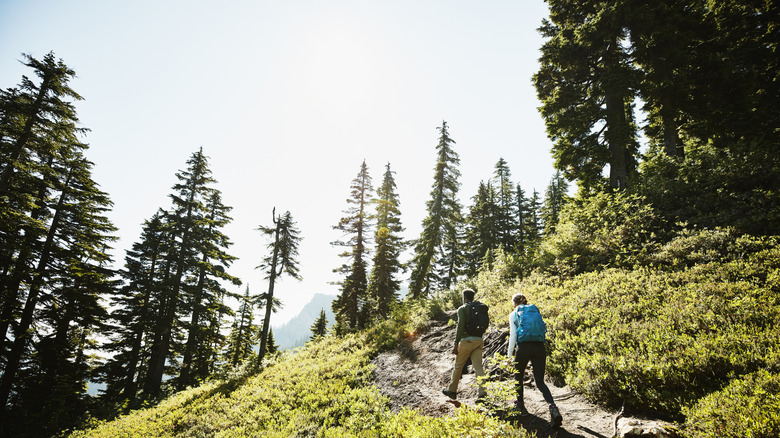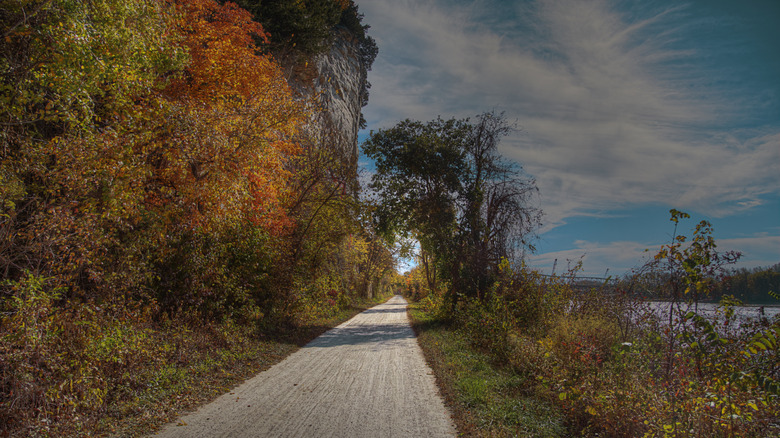The Longest Continuous Trail In America Offers An Epic Coast-To-Coast Hiking Adventure
Hiking blends together physical challenges, sharpens mental clarity, and can foster a deep connection to the natural world. It sharpens focus, strengthens the body, soothes the soul, and can offer respite from the hectic and busy requirements of day to day life. The US National Park System alone has more than 21,000 miles of trails for use, offering adventurers myriad opportunities to explore diverse landscapes across the country.
Among this trail system are thru-hikes, long-distance trails that are hiked from end-to-end in one continuous experience. Thru-hikes stand as a pinnacle of outdoor achievement for many, and popular hiking destinations on many people's bucket lists. Iconic trails like the Appalachian Trail, which stretches from Georgia to Maine in 2,190 miles, or the Pacific Crest Trail, which spans about 2,600 miles from Mexico to Canada, both draw thousands of intrepid backcountry hikers annually. Roughly 3,000 hikers attempt the AT each year, and the PCT sees similar ambitious hikers. These trails test the grit and endurance of many and reward them with incredible natural landscapes and personal triumph.
One trail surpasses them all in terms of scope and ambition: the American Discovery Trail. The ADT spans about 6,800 miles from the Atlantic to the Pacific Coast, and is the longest continuous trail in the US, connecting Cape Henlopen in Delaware, to Point Reyes National Seashore in California. Unlike its peers, the ADT isn't just a wilderness path, it's also a combination of urban streets, historic monuments, small-town charm, and rugged backcountry. The ADT invites hikers to traverse 15 states, blending outdoor adventure with cultural immersion. The ADT offers a singular opportunity to experience the heart of America on-foot.
The American Discovery Trail: a journey across the nation
The American Discovery Trail is a marvel of trail design, weaving through one third of the states and offering a choose your own adventure design. The trail is divided into four regions: Eastern, Central Northern, Central Southern and Western. Hikers most commonly begin in the east and end in the west, starting at Cape Henlopen, Delaware, and trek westward to Elizebethtown, Ohio.
It's here that the trail splits into northern and southern routes. The northern route is roughly 4,834 miles and cuts through Ohio, Indiana, Illinois, Iowa, Nebraska, and Colorado leading to Denver. The southern route is just over 5,000 miles and passes through Ohio, Indiana, Illinois, Missouri, Kansas, and Colorado. Both trails meet in Denver before continuing through Colorado, Utah, Nevada, and California to the Pacific to make up the western portion of the trail. Hikers can mix and match routes, and completely tailor the journey to fit their needs and preferences.
The trial is also multi-use, accommodating hikers, bikers, and even horseback riders along some portions. Other sections are ADA accessible as well, offering trail experiences for various uses and people. According to the American Discovery Trail Organization, if a hiker completed 15 miles a day with one rest day a week, completing the trail would take 400 days, which is the equivalent of 60 weeks (there are 52 in a year!). This trail stands out as a "national discovery trail" for both its remote and rugged wilderness alongside its urban pathways and experiences. Navigating it is uncomplicated with the data books and .gpx files from the ADT website.
Highlights of the American Discovery Trail
The ADT is a journey through America's soul, blending urban delights with natural celebrations and historic relevance. Starting in Delaware, the first state to ratify the Constitution, hikers get to explore Cape Henlopen's Dutch settlement history and WWII-era bunkers. The eastern section winds through Chesapeake Bay to Washington D.C., where the White House, Washington Monument, and the Smithsonian await exploration. Ohio's "Little Smokies" and rugged dolomite cliffs offer beautiful wilderness, and Cincinnati provides urban flair. History and nature flawlessly intertwine.
The Central and Western sections don't disappoint either. The northern route traverses Indiana's Hoosier National Forest and Iowa's rolling fields. The southern route follows Missouri's Katy Trail along the Missouri River, passing limestone cliffs and vineyards. The next state over, Kansas' Flint Hills offer solitude amid one of the world's tallest and largest grass prairies. Colorado brings the infamous Rockies, including 6 national forests and Leadville, the highest incorporated city in the US.
In Utah, hikers explore canyon country, full of red cliffs and slot canyons. The trail passes through the remote public lands of Nevada, through California's Sierra Nevada Mountain Range, and into the coastal forests of California. It reaches its end at Point Reyes' National Seashore. From Civil War historical sites to Native American heritage areas, urban hubs like Denver and San Francisco, and iconic parks like the Great Basin, the ADT is a 6,800 mile love letter to America's endless bounty.


